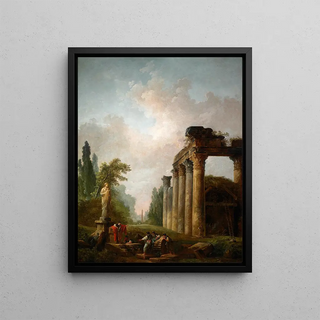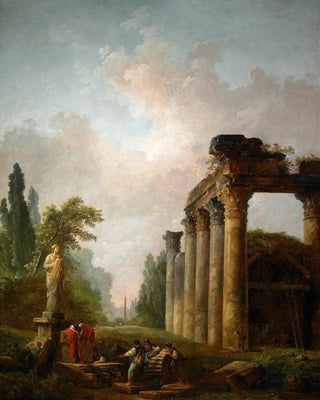Art print | The Ruin - Hubert Robert


View from behind

Frame (optional)
La Ruin - Hubert Robert – Captivating Introduction
In the fascinating world of art, certain works transcend their era to become timeless witnesses of human history. "La Ruine" by Hubert Robert is one of these iconic pieces, capturing the melancholic beauty of relics from the past. Painted in the 18th century, this canvas takes us on a journey through the ruins of an ancient structure, where nature reclaims its rights. The artwork evokes a deep reflection on the passage of time and the fragility of human creation. Contemplating this scene, one feels a connection with the artist, who invites us to meditate on the ephemeral beauty of our existence.
Style and uniqueness of the work
Hubert Robert, master of landscape, stands out for his unique approach to the subject. In "La Ruine," he skillfully combines classical architecture with lush nature, creating a striking harmony between artifice and naturalness. The meticulous details of the crumbling stones and overflowing foliage testify to his exceptional talent for staging. The play of light, subtly orchestrated, highlights the contours of the ruins while bathing the rest of the composition in a gentle shadow. This contrast enhances the sense of mystery and enigma emanating from the work. The color palette, blending warm and cool tones, creates an atmosphere that is both serene and nostalgic, allowing us to feel the very soul of this forgotten place.
The artist and his influence
Hubert Robert, often nicknamed "Robert des ruines," established himself as a major figure in 18th-century French landscape painting. His work aligns with the neoclassical movement, but he also incorporated elements of emerging Romanticism. As a painter and architect, Robert explored themes of ruins and nature throughout his career, influencing many contemporary and later artists. His perspective on relics of the past opened the way to a new appreciation of architecture as a narrative element in painting. Robert's landscapes remind us that beauty can reside in decay, and his legacy endures through the centuries, inspiring

Matte finish

View from behind

Frame (optional)
La Ruin - Hubert Robert – Captivating Introduction
In the fascinating world of art, certain works transcend their era to become timeless witnesses of human history. "La Ruine" by Hubert Robert is one of these iconic pieces, capturing the melancholic beauty of relics from the past. Painted in the 18th century, this canvas takes us on a journey through the ruins of an ancient structure, where nature reclaims its rights. The artwork evokes a deep reflection on the passage of time and the fragility of human creation. Contemplating this scene, one feels a connection with the artist, who invites us to meditate on the ephemeral beauty of our existence.
Style and uniqueness of the work
Hubert Robert, master of landscape, stands out for his unique approach to the subject. In "La Ruine," he skillfully combines classical architecture with lush nature, creating a striking harmony between artifice and naturalness. The meticulous details of the crumbling stones and overflowing foliage testify to his exceptional talent for staging. The play of light, subtly orchestrated, highlights the contours of the ruins while bathing the rest of the composition in a gentle shadow. This contrast enhances the sense of mystery and enigma emanating from the work. The color palette, blending warm and cool tones, creates an atmosphere that is both serene and nostalgic, allowing us to feel the very soul of this forgotten place.
The artist and his influence
Hubert Robert, often nicknamed "Robert des ruines," established himself as a major figure in 18th-century French landscape painting. His work aligns with the neoclassical movement, but he also incorporated elements of emerging Romanticism. As a painter and architect, Robert explored themes of ruins and nature throughout his career, influencing many contemporary and later artists. His perspective on relics of the past opened the way to a new appreciation of architecture as a narrative element in painting. Robert's landscapes remind us that beauty can reside in decay, and his legacy endures through the centuries, inspiring






